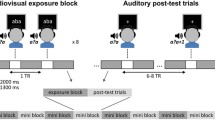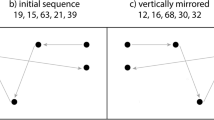Abstract
Associating letters with speech sounds is essential for reading skill acquisition. In the current study, we aimed at determining the effects of different types of visual material and temporal synchrony on the integration of letters and speech sounds. To this end, we recorded the mismatch negativity (MMN), an index of automatic change detection in the brain, from literate adults. Subjects were presented with auditory consonant–vowel syllable stimuli together with visual stimuli, which were either written syllables or scrambled pictures of the written syllables. The visual stimuli were presented in half of the blocks synchronously with the auditory stimuli and in the other half 200 ms before the auditory stimuli. The auditory stimuli were consonant, vowel or vowel length changes, or changes in syllable frequency or intensity presented by using the multi-feature paradigm. Changes in the auditory stimuli elicited MMNs in all conditions. MMN amplitudes for the consonant and frequency changes were generally larger for the sounds presented with written syllables than with scrambled syllables. Time delay diminished the MMN amplitude for all deviants. The results suggest that speech sound processing is modulated when the sounds are presented with letters versus non-linguistic visual stimuli, and further, that the integration of letters and speech sounds seems to be dependent on precise temporal alignment. Moreover, the results indicate that with our paradigm, a variety of parameters relevant and irrelevant for reading can be tested within one experiment.




Similar content being viewed by others
References
Alho K (1995) Cerebral generators of mismatch negativity (MMN) and its magnetic counterpart (MMNm) elicited by sound changes. Ear Hear 16(1):38–51
Alho K, Connolly JF, Cheour M, Lehtokoski A, Huotilainen M, Virtanen J, Aulanko R, Ilmoniemi RJ (1998) Hemispheric lateralization in preattentive processing of speech sounds. Neurosci Lett 258(1):9–12
Alku P, Tiitinen H, Näätänen R (1999) A method for generating natural-sounding speech stimuli for cognitive brain research. Clin Neurophysiol 110(8):1329–1333
Besle J, Fort A, Giard MH (2005) Is the auditory sensory memory sensitive to visual information? Exp Brain Res 166(3–4):337–344
Cheour M, Ceponiene R, Lehtokoski A, Luuk A, Allik J, Alho K, Näätänen R (1998) Development of language-specific phoneme representations in the infant brain. Nat Neurosci 1(5):351–353
Colin C, Radeau M, Soquet A, Deltenre P (2004) Generalization of the generation of a MMN by illusory McGurk percepts: Voiceless consonants. Clin Neurophysiol 115(9):1989–2000
Delorme A, Makeig S (2004) Eeglab: an open source toolbox for analysis of single-trial eeg dynamics including independent component analysis. J Neurosci Methods 134(1):9–21
Frost R, Repp BH, Katz L (1988) Can speech perception be influenced by simultaneous presentation of print? J Memory Lang 27:741–755
Froyen D, van Atteveldt N, Bonte M, Blomert L (2008) Cross-modal enhancement of the MMN to speech-sounds indicates early and automatic integration of letters and speech-sounds. Neurosci Lett 430(1):23–28
Froyen DJ, Bonte ML, van Atteveldt N, Blomert L (2009) The long road to automation: neurocognitive development of letter-speech sound processing. J Cogn Neurosci 21(3):567–580
Giard MH, Lavikainen J, Reinikainen K, Perrin F, Bertrand O, Pernier J, Näätänen R (1995) Seperate representation of stimulus frequency, intensity, and duration in auditory sensory memory: an event-related potential and dipole-model analysis. J Cognit Neurosci 7:133–143
Goswami U (2002) Cross-linguistic aspects of literacy development and dyslexia. Ann Dyslexia 52:141–163
Jaramillo M, Ilvonen T, Kujala T, Alku P, Tervaniemi M, Alho K (2001) Are different kinds of acoustic features processed differently for speech and non-speech sounds? Brain Res Cogn Brain Res 12(3):459–466
Kirmse U, Ylinen S, Tervaniemi M, Vainio M, Schröger E, Jacobsen T (2008) Modulation of the mismatch negativity (MMN) to vowel duration changes in native speakers of Finnish and German as a result of language experience. Int J Psychophysiol 67(2):131–143
Kujala T, Tervaniemi M, Schröger E (2007) The mismatch negativity in cognitive and clinical neuroscience: theoretical and methodological considerations. Biol Psychol 74(1):1–19
Lovio R, Pakarinen S, Huotilainen M, Alku P, Silvennoinen S, Näätänen R, Kujala T (2009) Auditory discrimination profiles of speech sound changes in 6-year-old children as determined with the multi-feature MMN paradigm. Clin Neurophysiol 120(5):916–921
Luck SJ (2005) An introduction to the event-related potential technique. The MIT Press, Cambridge
Massaro DW, Cohen MC, Thompson LA (1988) Visible language in speech perception: lipreading and reading. Visible Lang 22:8–31
McGurk H, MacDonald J (1976) Hearing lips and seeing voices. Nature 264(5588):746–748
Muller-Gass A, Stelmack RM, Campbell (2006) The effect of visual task difficulty and attentional direction on the detection of acoustic change as indexed by the mismatch negativity. Brain Res 1078:112–130
Näätänen R, Michie PT (1979) Early selective-attention effects on the evoked potential: a critical review and reinterpretation. Biol Psychol 8(2):81–136
Näätänen R, Gaillard AW, Mäntysalo S (1978) Early selective-attention effect on evoked potential reinterpreted. Acta Psychol (Amst) 42(4):313–329
Näätänen R, Lehtokoski A, Lennes M, Cheour M, Huotilainen M, Iivonen A, Vainio M, Alku P, Ilmoniemi RJ, Luuk A, Allik J, Sinkkonen J, Alho K (1997) Language-specific phoneme representations revealed by electric and magnetic brain responses. Nature 385(6615):432–434
Näätänen R, Pakarinen S, Rinne T, Takegata R (2004) The mismatch negativity (MMN): towards the optimal paradigm. Clin Neurophysiol 115(1):140–144
Näätänen R, Paavilainen P, Rinne T, Alho K (2007) The mismatch negativity (MMN) in basic research of central auditory processing: a review. Clin Neurophysiol 118(12):2544–2590
Novak GP, Ritter W, Vaughan HG Jr, Wiznitzer ML (1990) Differentiation of negative event-related potentials in an auditory discrimination task. Electroencephalogr Clin Neurophysiol 75(4):255–275
Paavilainen P, Alho K, Reinikainen K, Sams M, Näätänen R (1991) Right hemisphere dominance of different mismatch negativities. Electroencephalogr Clin Neurophysiol 78(6):466–479
Pakarinen S, Lovio R, Huotilainen M, Alku P, Näätänen R, Kujala T (2009) Fast multi-feature paradigm for recording several mismatch negativities (MMNs) to phonetic and acoustic changes in speech sounds. Biol Psychol 82(3):219–226
Pulvermüller F, Kujala T, Shtyrov Y, Simola J, Tiitinen H, Alku P, Alho K, Martinkauppi S, Ilmoniemi RJ, Näätänen R (2001) Memory traces for words as revealed by the mismatch negativity. Neuroimage 14(3):607–616
Rinne T, Alho K, Alku P, Holi M, Sinkkonen J, Virtanen J, Bertrand O, Näätänen R (1999) Analysis of speech sounds is left-hemisphere predominant at 100–150 ms after sound onset. NeuroReport 10:1113–1117
Sams M, Aulanko R, Hämäläinen M, Hari R, Lounasmaa OV, Lu ST, Simola J (1991) Seeing speech: visual information from lip movements modifies activity in the human auditory cortex. Neurosci Lett 127(1):141–145
Shtyrov Y, Kujala T, Ahveninen J, Tervaniemi M, Alku P, Ilmoniemi RJ, Näätänen R (1998) Background acoustic noise and the hemispheric lateralization of speech processing in the human brain: magnetic mismatch negativity study. Neurosci Lett 251(2):141–144
Shtyrov Y, Kujala T, Palva S, Ilmoniemi RJ, Näätänen R (2000) Discrimination of speech and of complex nonspeech sounds of different temporal structure in the left and right cerebral hemispheres. Neuroimage 12(6):657–663
Siegel LS, Faux D (1989) Acquisition of certain grapheme-phoneme correspondence in normally achieving and disabled readers. Read Writ : An Interdiscip J 1:37–52
Snowling MJ (1981) Phonemic deficits in developmental dyslexia. Psychol Res 43(2):219–234
Sorokin A, Alku P, Kujala T (2010) Change and novelty detection in speech and non-speech sound streams. Brain Res 1327:77–90
Sussman E, Ritter W, Vaughan HG Jr (1998) Attention affects the organization of auditory input associated with the mismatch negativity system. Brain Res 789(1):130–138
Swets JA (1964) Signal detection and recognition by human observers. Wiley, New York
Takegata R, Tervaniemi M, Alku P, Ylinen S, Näätänen R (2008) Parameter-specific modulation of the mismatch negativity to duration decrement and increment: evidence for asymmetric processes. Clin Neurophysiol 119(7):1515–1523
Tervaniemi M, Jacobsen T, Rottger S, Kujala T, Widmann A, Vainio M, Näätänen R, Schröger E (2006) Selective tuning of cortical sound-feature processing by language experience. Eur J Neurosci 23(9):2538–2541
Vainio M, Järvikivi J (2007) Focus in production: tonal shape, intensity and word order. J Acoust Soc Am 121 (2):EL55-61
van Atteveldt NM, Formisano E, Blomert L, Goebel R (2007) The effect of temporal asynchrony on the multisensory integration of letters and speech sounds. Cereb Cortex 17(4):962–974
Widmann A, Kujala T, Tervaniemi M, Kujala A, Schröger E (2004) From symbols to sounds: visual symbolic information activates sound representations. Psychophysiology 41(5):709–715
Widmann A, Gruber T, Kujala T, Tervaniemi M, Schröger E (2007) Binding symbols and sounds: evidence from event-related oscillatory gamma-band activity. Cereb Cortex 17(11):2696–2702
Winkler I, Kujala T, Tiitinen H, Sivonen P, Alku P, Lehtokoski A, Czigler I, Csepe V, Ilmoniemi RJ, Näätänen R (1999) Brain responses reveal the learning of foreign language phonemes. Psychophysiology 36(5):638–642
Woldorff MG, Hackley SA, Hillyard SA (1991) The effects of channel-selective attention on the mismatch negativity wave elicited by deviant tones. Psychophysiology 28(1):30–42
Woldorff MG, Hillyard SA, Gallen CC, Hampson SR, Bloom FE (1998) Magnetoencephalographic recordings demonstrate attentional modulation of mismatch-related neural activity in human auditory cortex. Psychophysiology 35(3):283–292
Yanz JL (1984) The application of the theory of signal detection to the assessment of speech perception. Ear Hear 5:64–71
Ylinen S, Shestakova A, Alku P, Huotilainen M (2005) The perception of phonological quantity based on durational cues by native speakers, second-language users and nonspeakers of Finnish. Lang Speech 48(Pt 3):313–338
Yucel G, Petty C, McCarthy G, Belger A (2005) Graded visual attention modulates brain responses evoked by task-irrelevant auditory pitch changes. J Cogn Neurosci 17(12):1819–1828
Acknowledgments
The present study was financially supported by the Centre for International Mobility (CIMO, Helsinki, Finland), the Academy of Finland (grant 122745), and the University of Helsinki. Special thanks to Prof. Paavo Alku for creating the auditory stimuli, and Mr. Michael Ranft for his valuable contribution in data analyses.
Author information
Authors and Affiliations
Corresponding author
Rights and permissions
About this article
Cite this article
Mittag, M., Takegata, R. & Kujala, T. The effects of visual material and temporal synchrony on the processing of letters and speech sounds. Exp Brain Res 211, 287–298 (2011). https://doi.org/10.1007/s00221-011-2686-z
Received:
Accepted:
Published:
Issue Date:
DOI: https://doi.org/10.1007/s00221-011-2686-z




